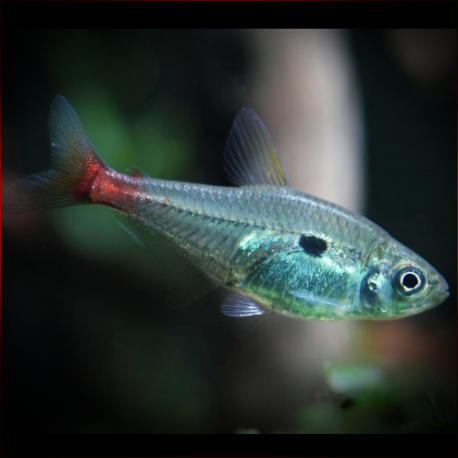More info
Datasheet
| Minimum Tank Size | 70 litres / 18.49 US gallons |
| Maximum Size | 6.0cm / 2.36inches |
| Temperature | 23°C / 73.40°F - 27°C / 80.60°F |
| Hardness | 1-12ºdH |
| pH | 5.5-7.0 |
General Description
The Hemigrammus Stictus, commonly known as the Red-Base Tetra, belongs to the Characidae family and can grow up to 6.0cm in size. Found in slow-moving rivers, tributaries, and floodplain lakes in Venezuela, Guyana, and Brazil, this species is subtly attractive when in good condition. As part of the tetra category, its taxonomic status within the Hemigrammus genus is currently uncertain, which houses over 70 small characin species.
Aquarium Setup
For optimal care, Hemigrammus Stictus requires a tank of at least 70 litres, arranged with river sand substrate, driftwood branches, twisted roots, and dried leaves to mimic its natural habitat. The water conditions should ideally maintain a pH of 5.5-7.0, temperature between 23-27°C, and a hardness of 1-12°dH. Peat filtration can aid in creating blackwater conditions. Alternatively, a heavily planted tank can also suit these tetras. A dimly lit environment with appropriate tank mates from South America fosters their well-being.
Behaviour
Red-Base Tetras are peaceful by nature and thrive in shoals of 6 or more individuals. In an aquarium setting, they coexist well with other South American species like pencil fish, dwarf cichlids, and small Loricariids. Ensuring they are kept in groups enhances their visual appeal and overall health.
Feeding and Diet
In the wild, Hemigrammus Stictus predominantly feeds on small invertebrates. In captivity, they are not picky eaters and accept a varied diet of dried flakes, granules, small live, and frozen foods. A balanced diet keeps these tetras healthy and vibrant.
Reproduction & Dimorphism
Breeding Red-Base Tetras involves providing proper breeding conditions in a separate tank with soft, acidic water and low lighting. They can be spawned in groups or pairs, with precautions taken against adults consuming the eggs. After hatching, fry should be fed with suitable food until they are large enough to accept microworms or brine shrimp nauplii. Adult males are slightly smaller and slimmer than females.
Habitat and Distribution
These tetras inhabit slow-moving rivers, tributaries, and floodplain lakes in Venezuela, Guyana, and Brazil. Their natural habitat comprises dimly lit waters with minimal aquatic plants, making them adaptable to biotope setups in captivity.

